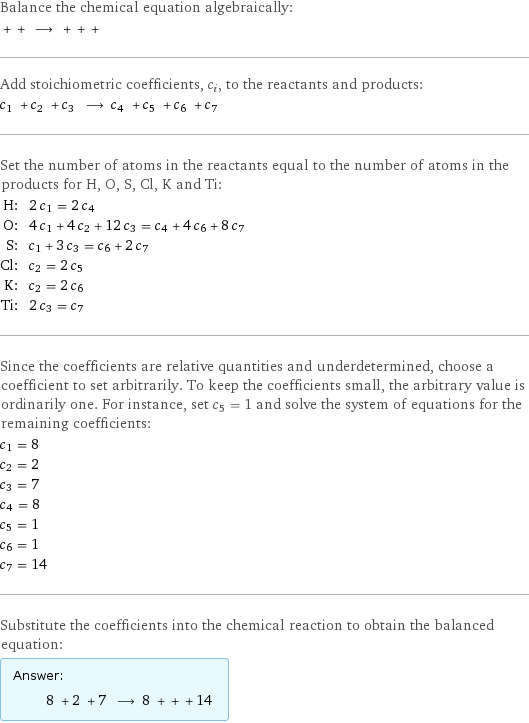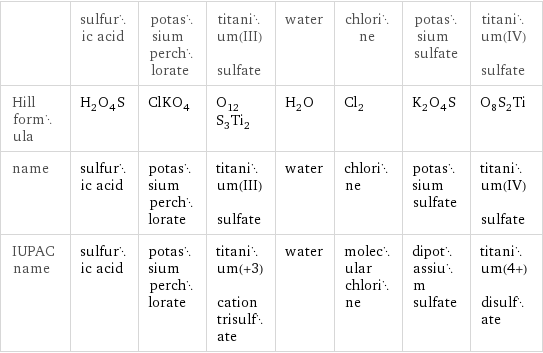Input interpretation

sulfuric acid + potassium perchlorate + titanium(III) sulfate ⟶ water + chlorine + potassium sulfate + titanium(IV) sulfate
Balanced equation

Balance the chemical equation algebraically: + + ⟶ + + + Add stoichiometric coefficients, c_i, to the reactants and products: c_1 + c_2 + c_3 ⟶ c_4 + c_5 + c_6 + c_7 Set the number of atoms in the reactants equal to the number of atoms in the products for H, O, S, Cl, K and Ti: H: | 2 c_1 = 2 c_4 O: | 4 c_1 + 4 c_2 + 12 c_3 = c_4 + 4 c_6 + 8 c_7 S: | c_1 + 3 c_3 = c_6 + 2 c_7 Cl: | c_2 = 2 c_5 K: | c_2 = 2 c_6 Ti: | 2 c_3 = c_7 Since the coefficients are relative quantities and underdetermined, choose a coefficient to set arbitrarily. To keep the coefficients small, the arbitrary value is ordinarily one. For instance, set c_5 = 1 and solve the system of equations for the remaining coefficients: c_1 = 8 c_2 = 2 c_3 = 7 c_4 = 8 c_5 = 1 c_6 = 1 c_7 = 14 Substitute the coefficients into the chemical reaction to obtain the balanced equation: Answer: | | 8 + 2 + 7 ⟶ 8 + + + 14
Structures

+ + ⟶ + + +
Names

sulfuric acid + potassium perchlorate + titanium(III) sulfate ⟶ water + chlorine + potassium sulfate + titanium(IV) sulfate
Chemical names and formulas

| sulfuric acid | potassium perchlorate | titanium(III) sulfate | water | chlorine | potassium sulfate | titanium(IV) sulfate Hill formula | H_2O_4S | ClKO_4 | O_12S_3Ti_2 | H_2O | Cl_2 | K_2O_4S | O_8S_2Ti name | sulfuric acid | potassium perchlorate | titanium(III) sulfate | water | chlorine | potassium sulfate | titanium(IV) sulfate IUPAC name | sulfuric acid | potassium perchlorate | titanium(+3) cation trisulfate | water | molecular chlorine | dipotassium sulfate | titanium(4+) disulfate